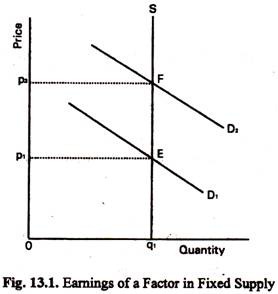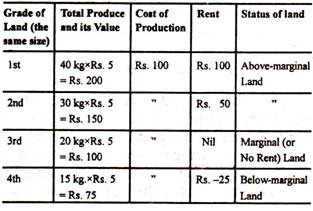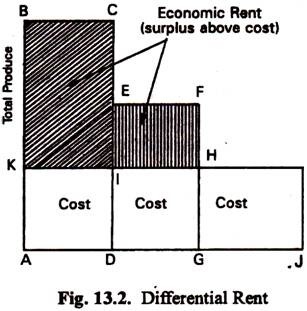Read this article to learn about the Ricardian theory of rent.
- Explanation of the Theory
- Assumptions of the Theory
- Reasons for Existence of Rent
- Deductions from the Theory
- Criticisms of the Theory
Explanation of the Theory:
David Ricardo, an English classical economist, first developed a theory in 1817 to explain the origin and nature of economic rent.
Ricardo used the economic and rent to analyse a particular question. In the Napoleonic wars (18.05-1815) there were large rise in corn and land prices.
Did the rise in land prices force up the price of corn, or did the high price of corn increase the demand for land and so push up land prices. Ricardo defined rent as, “that portion of the produce of the earth which is paid to the landlord for the use of the original and indestructible powers of the soil.” In his theory, rent is nothing but the producer’s surplus or differential gain, and it is found in land only.
Assumptions of the Theory:
The Ricardian theory of rent is based on the following assumptions:
ADVERTISEMENTS:
1. Rent of land arises due to the differences in the fertility or situation of the different plots of land. It arises owing to the original and indestructible powers of the soil.
2. Ricardo assumes the operation of the law of diminishing marginal returns in the case of cultivation of land. As the different plots of land differ in fertility, the produce from the inferior plots of land diminishes though the total cost of production in each plot of land is the same.
3. Ricardo looks at the supply of land from the standpoint of the society as a whole.
ADVERTISEMENTS:
4. In the Ricardian theory it is assumed that land, being a gift of nature, has no supply price and no cost of production. So rent is not a part of cost, and being so it does not and cannot enter into cost and price. This means that from society’s point of view the entire return from land is a surplus earning.
Reasons for Existence of Rent:
According to Ricardo rent arises for two main reasons:
(1) Scarcity of land as a factor and
(2) Differences in the fertility of the soil.
Scarcity Rent:
ADVERTISEMENTS:
Ricardo assumed that land had only one use—to grow corn. This meant that its supply was fixed, as shown in Figure 13.1. Hence the price of land was totally determined by the demand for land. In other words, all the price of a factor of production in perfectly inelastic supply is economic rent—it has no transfer earnings.
Thus, it was the high price of corn which caused an increase in the demand for land and a rise in its price, rather than the price of land pushing up the price of corn. However, this analysis depends on the assumption that land has only one use. In the real world a particular piece of land can be put to many different uses. This means its supply for any one use is elastic, so that it has transfer earnings.
Differential Rent:
According to Ricardo, rent of land arises because the different plots of land have different degree of productive power; some lands are more fertile than others. So there are different grades of land. The difference between the produce of the superior lands and that of the inferior lands is rent—what is called differential rent. Let us illustrate the Ricardian concept of differential rent.
Differential Rent on account of differences in the fertility of soil:
Ricardo assumes that the different grades of lands are cultivated gradually in descending order—the first grade land being cultivated at first, then the second grade, after that the third grade and so on. With the increase in population and with the consequent increase in the demand for agricultural produce, inferior grades of lands are cultivated, creating a surplus or rent for the superior grades. This is illustrated in Table 13.1.
Table 13.1: Calculation of Differential Rent
Table 13.1 shows the position of 3 different plots of land of equal size. The total cost is the same for each plot of land. Let us assume that the order of cultivation reaches the third stage when all the three plots of land of different grades are cultivated and the market price has come to the level of Rs. 5 per kg of wheat.
ADVERTISEMENTS:
The first grade land, being the most fertile, produces 40 kg, the second grade 70 kg and the third grade land, being less fertile, only 20 kg. So, the first grade land earns a surplus or rent of Rs. 100, the second grade a rent of Rs. 50 and the third one earns no surplus. The first two plots are called the intra-marginal and the third one is the marginal (or no-rent) land. This simple example shows how the differences in the fertility of the different plots of land create rent for the superior plots of lands.
The concept of differential rent arising due to differences in the fertility of different plots of land is illustrated in Fig. 13.2.
Here, AD, DG and GJ are three separate plots of land of the same size, but of difference in fertility. The total produce of AD is ABCD, that of DG is DEFG and that of GJ is GHIJ. The first and second plots of land generate a surplus shows by the shaded area, which represents the rent of the first two plots of land. Since the third plot GJ has no surplus it is marginal land or no-rent land. Grade 4 (below-marginal) land will not be cultivated, because rent is negative (Rs. 25 in this example).
Rent and Price:
ADVERTISEMENTS:
From the Ricardian theory we can show the relation between rent (of land) and price (of wheat). Since the market price of wheat is determined by costs of the marginal producer and since, for this marginal producer, rents are zero, Ricardo concluded that economic rent is not a determinant of market price. Rather, price of wheat is determined solely by the market demand for wheat and the availability of fertile land.
Deductions from the Theory:
If rent depends on price and on the superiority of rent-producing land over marginal land, we can deduce the following:
1. Improved methods of farming:
Improved methods of cultivation may lead to a fall in rent (demand remaining unchanged). It is because increased output on the superior grades of land will make the cultivation of inferior grades of land unnecessary.
ADVERTISEMENTS:
2. Population growth:
Population growth is likely to lead to a rise in rent, since the increased demand for land will bring poor quality land into cultivation, thus lowering the output of marginal land. Thus, if the price of food increases, the rent of existing land will increase.
3. Improved transport facilities:
Improved transport facilities are likely to lead to a fall in rent. It is because the output of less fertile land of foreign countries may be able to compete more closely with the home produce. So there will be no need to cultivate inferior home areas. As a result the output of the marginal land rises and rent falls.
Thus, it is difficult to say whether or not rent increases with economic progress. However, rent is likely to fall with economic progress if population growth is unable to fully neutralise the effects of technological progress and improvement in transport facilities.
Criticisms of the Theory:
Ricardian theory has been criticised on the following grounds:
ADVERTISEMENTS:
1. Ricardo considers land as fixed in supply. Of course, land is fixed in an absolute sense. But land has alternative uses. So the supply of land to a particular use is not fixed (inelastic). For example, the supply of wheat land is not absolutely fixed at any given time.
2. Ricardo’s order of cultivation of lands is also not realistic. If the price of wheat falls the marginal land need not necessarily go out of cultivation first. Superior grades of land might cease to be cultivated if a fall in the price of its output causes such land being demanded for other purposes (e.g., for constructing houses).
3. The productivity of land does not depend entirely on fertility. It also depends on such factors as position, investment and effective use of capital.
4. Critics have pointed out that land does not possess any original and indestructible powers, as the fertility of land gradually diminishes, unless fertilisers are applied regularly.
5. Ricardo’s assumption of no-rent land is unrealistic as, in reality; every plot of land earns some rent, although the amount may be small.
6. Ricardo restricted rent to land only, but modern economists have shown that rent arises in return to any factor of production, the supply of which is inelastic.
ADVERTISEMENTS:
7. According to Ricardo, rent does not enter into price (cost) but from the point of view of an individual farm rent forms a part of cost and price.
Conclusion:
In spite of the various shortcomings of the Ricardian theory, it cannot be discarded—as Stonier and Hague remarked — “The concept of transfer earnings helps to bring the simple Ricardian theory of rent into closer relation with reality.”


